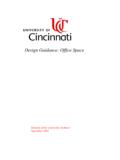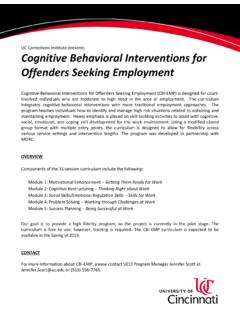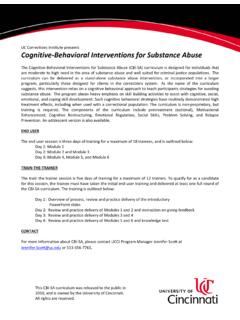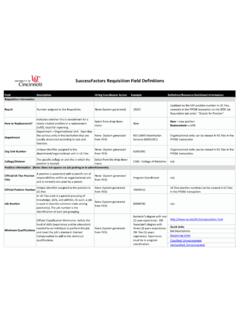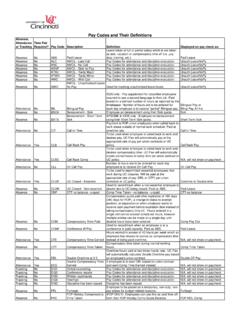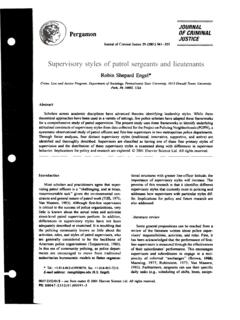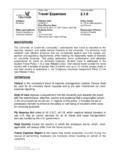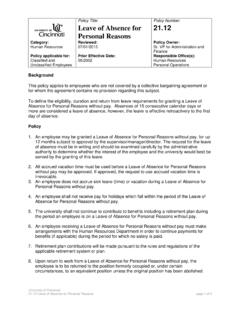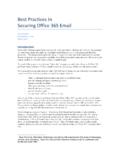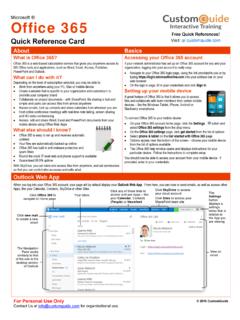Transcription of Design Guidance: Office Space - University of Cincinnati ...
1 Design guidance : Office Space Division of the University Architect September 2003. Table of Contents INTRODUCTION ..3. HISTORY ..3. Integration with Master Plan Initiatives and Strategies ..4. Integration of Quality of Life Standards for All Students, Faculty, and Staff ..4. Integration with Industry ..5. Integration of Responsible Use of Funds and OBJECTIVES ..6. Space PLANNING ..7. GOVERNING PHILOSOPHY FOR Office Space PLANNING ..7. OTHER Office SPACES ..8. ORGANIZING PRINCIPLES ..8. Planning Principles ..8. Other REQUIREMENTS FOR Design COMPLIANCE ISSUES AND SPECIAL REQUIREMENTS ..9. Space Office TYPES ..10. Design ELEMENTS.
2 10. Finishes ..10. STANDARD Space SIZES AND FINISHES ..10. AVAILABLE Office LAYOUTS ..12. PRINCIPLES FOR VARIANCES ..38. Variance Requests During Design ..38. Variance Requests After Occupancy ..38. Illustrations Available Office Layouts Optional Office Furniture Panel Height Options (in example 8' x 8' workstation). University of Cincinnati 2. Division of the University Architect Design guidance : Office Space Introduction September 2003. Introduction The University of Cincinnati 's Design guidance : Office Space was developed as a reference for University personnel, Associate Architects, furniture dealerships, furniture manufacturers, and contractor personnel who are involved in the Design , furnishing, construction, and/or use of new and renovated Office areas.
3 It presents guidance for the allocation and Design of Office Space at the University . The guidance was developed through research of Office environments in both higher education and industry, utilizing campus planners, architects, and interior designers who have extensive experience in designing many different kinds of Office Space . The team obtained information from a variety of sources, including: A comprehensive review of University personnel classifications A review of comparative information about Office standards at other universities Visits to other campuses Input from professional Design teams with a diverse range of experience Input obtained from presentations made at professional conferences History The need for a comprehensive set of standards for the allocation and Design of all University Office Space has become apparent, and the precedent for this has been established.
4 The concepts embedded in these standards have been applied to University Hall, University Pavilion, The Student Life Center, and other projects at the University . With increasing application, these concepts have been refined, and have been developed into this document. The University now has an opportunity to take advantage of the knowledge gained from these recent applications. By applying this knowledge across the board, the University can realize the benefits a high-quality Office environment can deliver in terms of recruitment, retention, and increased fiscal effectiveness. This comprehensive level of thinking is commensurate with the concepts embedded within the Master Plan; further, it integrates the same attention to the interior details of the workplace as has been given to our MainStreet and other Master Plan initiatives.
5 A standard policy for the equitable allocation and Design of Office Space at the University of Cincinnati is consistent with the strategies of the Master Plan. The policy also is not without precedent, as is outlined below. University of Cincinnati 3. Division of the University Architect Design guidance : Office Space Introduction September 2003. Integration with Master Plan Initiatives and Strategies The Master Plan contains several initiatives that support the desire for universally applied Office Space standards: The 1991 Edition introduced the concept of Connective Strategy, emphasizing, among other points, the celebration of innovation.
6 The 1995 Edition added the Three Imperatives, of which one is to provide new academic and research Space and facilities on campus. The 1995 Edition added a Fourth Imperative, Quality of Student Life and Services. Among other goals, this imperative includes the attraction and retention of top-quality students, and the creation of a physical environment reflecting the idea that learning takes place at all times, in a range of places in and beyond the classroom. Specifically, the Master Plan points out: A strong campus community, fostered by an attractive and cohesive, interconnected physical environment, with a high quality of student services, is critical for the University to remain competitive academically.
7 The quality of the work environment where students will interact with University employees and faculty . contributes extensively to the ability to recruit and retain top-quality students, faculty, and staff. The scope of this vision, therefore, is naturally recognized to include the interiors of our buildings and the furnishings within. Such conclusions have been applied to date in the construction and renovation of facilities. In keeping with the overriding goals of the Master Plan, the University recognizes that the quality of the University 's Office Space and the furnishings within must continue to be brought up to par, in a similar fashion as its academic, research, and open Space .
8 Integration of Quality of Life Standards for All Students, Faculty, and Staff The University of Cincinnati is one of the largest employers in the Cincinnati region, with an equally significant economic impact. In this capacity, the University employs over 13,000. full- and part-time faculty, staff, and students dispersed over a wide range of research, academic, and administrative disciplines and functions. As the University continues to improve the quality of its facilities and assets, the same concepts applied to recent projects should be applied. To follow our policy of improving academic, student, and research facilities, along with open Space , to the same level of quality, we need to follow a similar path in the Design of future facilities from the purchase or replacement of furniture, to building renovations, to the Design of new buildings.
9 The University has the opportunity to benefit from the impact of well-crafted Space and interiors. It is known that students base their decision to attend a University on the first few University of Cincinnati 4. Division of the University Architect Design guidance : Office Space Introduction September 2003. minutes of a campus visit. The quality of the work environment is recognized to play a part in a job candidate's decision to work for a particular employer. The impressions on surrounding communities have lasting impacts. The growing policy toward open access and broader use of facilities emphasizes the role departments have as ambassadors for the University .
10 An ordered and systematic method for allocating Space and furnishings focuses attention to quality, from the Space to the workstation. Such an approach also helps the University remain competitive in recruitment and retention. These concepts have been applied to such recent projects as Braunstein Hall, Baldwin Hall, Swift Hall, The Student Life Center, University Hall, and University Pavilion, among others. Integration with Industry The concepts of value-based asset management and universal application of Space standards have been in place in industry for many years. Within higher education, the application of Space and furniture standards has grown, with many universities implementing a codified method for allocating and designing Office Space .
